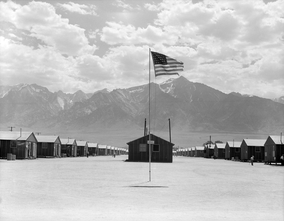
Are you a teacher who is interested in learning more about California History? Do you want ideas to take back to your classroom to use immediately? If so, learn more about my California History Courses from Fresno Pacific University. Take up to one year to complete my online self paced courses.
In the Aftermath of the Japanese attack on Pearl Harbor in 1941, the United States government ordered the forced removal and incarceration of Japanese Americans living on the West Coast. The internment was carried out by the War Relocation Authority (WRA), an agency created by President Franklin D. Roosevelt. Over 120,000 people, including U.S. citizens, were sent to internment camps in remote areas of the country, in Arizona, Arkansas, California, Colorado, Idaho, Utah, and Wyoming. The first internment camp opened in March 1942 at Manzanar, California. The last camp closed in March 1946.
The internment was based on the fear that Japanese Americans might be disloyal and could pose a security threat to the United States. There was no evidence to support this threat. In fact, many Japanese Americans had served in the U.S. military and had shown their loyalty to their country.
The conditions in the internment camps were harsh. They were overcrowded and unsanitary. People were forced to live in barracks with little privacy and had to share limited resources. They were also denied basic rights, such as the right to vote and the right to own property.
The internment had a devastating impact on Japanese Americans. They lost their homes, their businesses, and their livelihoods. Many families were separated, and some children were born in the camps. The experience of internment left a lasting legacy of pain and suffering.
In 1988, the U.S. government issued a formal apology for the internment and paid reparations to the survivors. However, the internment remains a dark chapter in American history. It is a reminder of the dangers of prejudice and discrimination, and it is a call to action to ensure that such a tragedy never happens again.
Receive $15 off my courses by entering promo code Winter45.
In the Aftermath of the Japanese attack on Pearl Harbor in 1941, the United States government ordered the forced removal and incarceration of Japanese Americans living on the West Coast. The internment was carried out by the War Relocation Authority (WRA), an agency created by President Franklin D. Roosevelt. Over 120,000 people, including U.S. citizens, were sent to internment camps in remote areas of the country, in Arizona, Arkansas, California, Colorado, Idaho, Utah, and Wyoming. The first internment camp opened in March 1942 at Manzanar, California. The last camp closed in March 1946.
The internment was based on the fear that Japanese Americans might be disloyal and could pose a security threat to the United States. There was no evidence to support this threat. In fact, many Japanese Americans had served in the U.S. military and had shown their loyalty to their country.
The conditions in the internment camps were harsh. They were overcrowded and unsanitary. People were forced to live in barracks with little privacy and had to share limited resources. They were also denied basic rights, such as the right to vote and the right to own property.
The internment had a devastating impact on Japanese Americans. They lost their homes, their businesses, and their livelihoods. Many families were separated, and some children were born in the camps. The experience of internment left a lasting legacy of pain and suffering.
In 1988, the U.S. government issued a formal apology for the internment and paid reparations to the survivors. However, the internment remains a dark chapter in American history. It is a reminder of the dangers of prejudice and discrimination, and it is a call to action to ensure that such a tragedy never happens again.
Receive $15 off my courses by entering promo code Winter45.

 RSS Feed
RSS Feed